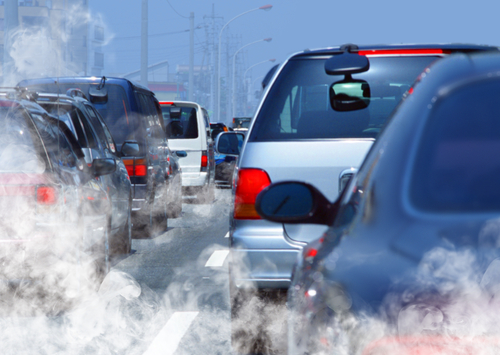Impacts of Near-Roadway Air Pollution
 |
It’s the rare person that has not had the unfortunate experience of driving too close to a vehicle like a heavy-duty diesel truck and getting a car full of smelly exhaust. But the everyday impacts of the cumulative emissions on major roads are also under scrutiny by the Environmental Protection Agency (EPA) due to their effects on public health.
According to the EPA, air pollutants from motor vehicles “are found in higher concentrations near major roads.” These “directly emitted” pollutants are composed of hundreds of substances including particulate matter (PM), carbon monoxide (CO), oxides of nitrogen (NOx), and benzene. Motor vehicle exhaust also contains compounds that help to form other air pollutants in the atmosphere, such as nitrogen dioxide (NO2), which the EPA says “is found in elevated concentrations near major roads, and ozone (O3), which forms further downwind.” In addition to tailpipe exhausts, roadway traffic can also produce dust and emit brake and tire debris.
Taken together or alone, these pollutants are associated with adverse health effects, and for those that spend long periods of time near major roads, they can be especially problematic. Among the many health problems cited by the EPA are:
- Asthma onset and aggravation,
- Cardiovascular disease,
- Reduced lung function, impaired lung development in children,
- Preterm and low-birth-weight infants,
- Childhood leukemia, and
- Premature death.
Forget expensive calls to lawyers and consultants. With Enviro.BLR.com, you get instant access, 24/7. Try it out today and get the 2015 EHS Salary Guide, absolutely free. Download Now.
But what qualifies as a major road and just how close does a person have to be to be impacted by the air pollution? Different studies have looked at these two questions in different ways so there are no exact specifications but here’s what research has shown. Regarding the definition of a “major road,” some researchers define it qualitatively (such as “a highway”), while others use quantitative qualifiers like annual average daily traffic. Similarly, proximity to a major road may be assessed at a specific distance (e.g., within 100–300 meters from a home or school), while other studies used pollutants estimated using dispersion modeling, land-use regression, or other statistical models. In the end, the EPA says that while there is no clear definition of “near or far from a road … in most cases, concentrations are generally highest on and/or nearest the roadway, while increasing distance from the road generally reduces concentrations to background levels within 500–600 feet though this distance will vary by pollutant in time and location…”
On a national scale, in 2009 the EPA estimated that “more than 45 million people in the United States lived within 300 feet of a highway with four or more lanes, a railroad, or an airport, and population trends suggest this number is increasing.” Moreover, many schools and daycare operations are located with “a few hundred feet” of highways and, each day, “the average American spends more than an hour in travel, most of which takes place on major roadways.”
Everything You Need for Environmental Compliance
Enviro.BLR.com puts everything you need at your fingertips, including practical RCRA, CAA, CWA, hazardous waste regulatory analysis and activity, news, and compliance tools. Try it at no cost or risk and get a FREE report.
In addition to proximity, other factors also affect air quality near major roadways, including:
- Type of vehicle and fuel used—heavy-duty diesel trucks emit more NOx and PM, while light-duty gasoline vehicles emit more CO, benzene, and volatile organic compounds (VOCs),
- Traffic activity—more traffic usually means greater emissions as do stop-and-go and high-speed traffic,
- Wind speed and direction—for example, the combination of rush-hour traffic and calm winds can lead to the highest pollutant concentrations on that day, and
- The presence of sound walls, buildings, and vegetation—all of which can have an impact on pollutant dispersion.
Although near-roadway air pollution can impact anyone, the groups most at risk include:
- Children and the elderly,
- Those with asthma and other respiratory diseases,
- Those with risk factors for heart disease and stroke,
- Those with preexisting cardiopulmonary disease, and
- Those of low socioeconomic status.
